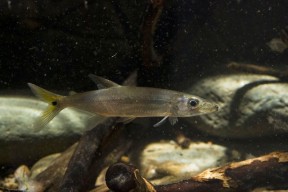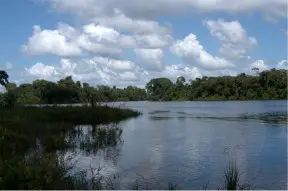Acestrorhynchus microlepis
SynonymsTop ↑
Hydrocyon microlepis Jardine, 1841; Acestrorhynchus cachorro Fowler, 1940; Acestrorhynchus guianensis Menezes, 1969; Acestrorhynchus apurensis Toledo-Piza & Menezes, 1996
Etymology
microlepis: from the Greek mikros, meaning ‘small’, and lepis, meaning ‘scale’.
Classification
Order: Characiformes Family: Acestrorhynchidae
Distribution
Type locality is given as ‘Rio Negro; Rio Branco; and Essiquibo River, South America’, and this species is widely distributed throughout northern drainages of the Amazon in Peru, Ecuador and Brazil plus the Río Orinoco in Venezuela and various coastal river systems in Guyana, Suriname and French Guiana.
Habitat
Inhabits major river channels and tributaries, and typically moves into flooded zones during the wet season.
Maximum Standard Length
The largest officially-recorded specimen measured 260 mm.
Aquarium SizeTop ↑
Acestrorhynchids are typically very active and extremely fast swimmers so minimum base dimensions in the region of 250 ∗ 90 cm are required for long-term care.
Even juveniles need a significant amount of room since they tend to act skittishly in small tanks and can easily injure themselves by swimming into the glass.
Maintenance
This species is a near-exclusive inhabitant of open water and an excess of cover can actually stress it meaning, substrate aside, the majority of the tank should be décor-free with plenty of open space.
Should you wish to create a natural effect use a sandy substrate, perhaps with a few handfuls of leaf litter and some driftwood branches or roots.
Plants which can grow in sand can also be added as can those which prefer to be attached to solid surfaces such as Microsorum pteropus, Taxiphyllum barbieri or Anubias spp. while lighting can simply be tailored to the plants being used.
If using a deeper tank you could even fill it to 50-70% of capacity and add emergent branches or plants which can look very effective.
A tightly-fitting cover should be used in all cases since acestrorhynchids tend to be powerful jumpers.
Efficient filtration is a must when keeping predatory species due to the amount of waste produced so install one or more external canister filters and/or a sump system, organising the return in such a way that some surface movement is created.
Weekly water changes of 30-50% should be considered mandatory as this species can be sensitive to organic pollutants¡ and swings in water chemistry, and for this reason it must never be introduced to biologically immature set-ups.
Water Conditions
Temperature: 22 – 28 °C
pH: 6.0 – 7.5
Hardness: 18 – 215 ppm
Diet
An obligate piscivore capable of consuming quite large prey in relation to its body size although it tends to focus on smaller prey such as tetras and related species.
Newly-imported specimens may refuse to accept anything but live fishes although most can be weaned onto dead alternatives once they recognise them as edible, and some even learn to accept dried foods.
Like the vast majority of predatory fishes this species should not be fed mammalian or avian meat such as beef heart or chicken.
Some of the lipids contained in these cannot be properly metabolised by the fish and may cause excess fat deposits and even organ degeneration.
Similarly there is no benefit in the use of ‘feeder’ fish such as livebearers or small goldfish which carry with them the risk of parasite or disease introduction and at any rate tend not have a high nutritional value unless properly conditioned beforehand.
Behaviour and CompatibilityTop ↑
Relatively peaceful with anything too large to swallow and can be maintained in a community provided tankmates are chosen with care.
Aggressively territorial or very competitive species should be avoided with the best choices being placid fishes such as Geophagus spp., Acarichthys heckelii, medium-sized doradid or loricariid catfishes and characids from genera like Ctenolucius, Mylossoma or Myloplus.
This species is not aggressive towards conspecifics with juveniles in particular exhibiting a marked schooling instinct.
Older individuals tend to be more solitary but still group together from time-to-time, and it’s best maintained in numbers of four or more.
One important point to note is that acestrorhynchids are cannibalistic given the opportunity so if buying a group or adding to an existing school try to ensure that all individuals are of comparable size.
Sexual Dimorphism
Sexually mature females tend to grow a little larger and be deeper-bodied than males.
Reproduction
Observations of the congener A. falcatus suggest that spawning occurs in midwater with the female remaining stationary while the male swims around her in a ‘figure-of-eight’ pattern.
The eggs are scattered in large numbers and parental care is non-existent.
NotesTop ↑
This species is a member of the putative A. microlepis group of closely-related species within the genus alongside A. britskii, A. grandoculis and A. minimus.
These are characterised by possession of a small, blackish, spot located just behind the gill cover versus, for example, a much larger marking in the A. lacustris group.
The exception is A. minimus which possesses no such marking but is tentatively considered to have lost it following divergence from the group’s common ancestor.
Recent morphological (Toledo-Piza, 2007) and molecular (Pretti et al., 2009) phylogenetic studies have been unable to recover the precise relationships existing within the group which traditionally included just A. grandoculis and A. microlepis.
The latter pair are very similar to one another and are only distinguishable by a handful of morphometric counts including the following: 91-131 lateral line scales in A. microlepis vs. 77-87 in A. grandoculis; eye diameter approximately 17.9-34.1 % of head length vs. 31.1-36.6 %; snout length 32.5-50.0 % of head length vs. 26.3-33.3 %.
Menezes’ (1969) diagnosed A. microlepis using the following combination of characters: 2 spinous and 9 soft dorsal-fin rays; 5 spinous and 25-31 soft anal-fin rays; 13-18 pectoral-fin rays; 8 ventral-fin rays; 108-122 pored lateral-line scales; 20-22 scale rows between lateral line and dorsal-fin origin; scale rows between lateral line and anal-fin origin; 20-26 rakers on lower part of first gill arch; a small, indistinct black marking at the origin of the lateral line, posterior to the opercle; a nearly round black blotch at the caudal-fin base.
As well as lacking the dark humeral marking, A. microlepis can be told apart by its small adult size with a maximum known SL of 91.5 mm, possession of less lateral line scales than A. microlepis (74-85 vs. 91-131), less scales between the lateral line and dorsal-fin than in A. grandoculis (12-14 vs. 16-17), plus it has a thin, darkish stripe extending from behind the opercle to around two-thirds body length.
We’ve never seen an image of live A. britskii but apparently it has a dark stripe extending from behind the opercle to the caudal peduncle .
The remainder of the genus is currently composed as follows:
A. lacustris group: A. abbreviatus, A. altus, A. lacustris, A. pantaneiro, possibly A. falcatus
A. nasutus group: A. falcirostris, A. nasutus, A. isalineae, possibly A. maculipinnis
Not assignable to any group: A. heterolepis
The family Acestrorhynchidae appears most closely-related to the Cynodontidae which contains the genera Cynodon, Hydrolycus and Rhaphiodon.
References
- Géry, J., 1977 - T.F.H. Publications, Inc.: 1-672
Characoids of the World. - López-Fernández, H. and K. O. Winemiller, 2003 - Ichthyological Exploration of Freshwaters 14(3): 193-208
Morphological variation in Acestrorhynchus microlepis and A. falcatus (Characiformes: Acestrorhynchidae), reassessment of A. apurensis and distribution of Acestrorhynchus in Venezuela. - Menezes, N. A., 1969 - Arquivos de Zoologia (São Paulo) 18(1-2): 1-150
Systematics and evolution of the tribe Acestrorhynchini (Pisces, Characidae). - Nico, L. G. and D. C. Taphorn, 1985 - Copeia 1985(3): 794-796
Diet of Acestrorhynchus microlepis (Pisces: Characidae) in the Low Llanos of Venezuela. - Prettia, V. Q., D. Calcagnottoa, M. Toledo-Piza and L. F. de Almeida-Toledo, 2009 - Molecular Phylogenetics and Evolution 52(2): 312–320
Phylogeny of the Neotropical genus Acestrorhynchus (Ostariophysi: Characiformes) based on nuclear and mitochondrial gene sequences and morphology: A total evidence approach. - Reis, R. E., S. O. Kullander and C. J. Ferraris, Jr. (eds.), 2003 - EDIPUCRS, Porto Alegre: i-xi + 1-729
Check list of the freshwater fishes of South and Central America. CLOFFSCA. - Toledo-Piza, M., 2007 - Zoological Journal of the Linnean Society 151(4): 691–757
Phylogenetic relationships among Acestrorhynchus species (Ostariophysi: Characiformes: Acestrorhynchidae). - Toledo-Piza, M. and N. A. Menezes, 1996 - American Museum Novitates No. 3160: 1-23
Taxonomic redefinition of the species of Acestrorhynchus of the microlepis group with the description of Acestrorhynchus apurensis, a new species from Venezuela (Ostariophysi: Characiformes: Characidae).




